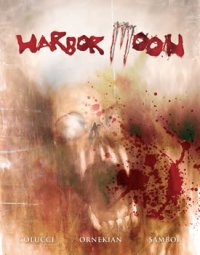 Harbor Moon OGN (Arcana, $19.95)
Harbor Moon OGN (Arcana, $19.95)
By Adam Prosser
A lot of comics readers, rather shamefully, don’t seem to appreciate just how big a role art plays in comics. I don’t mean they don’t appreciate the technical aspects of illustration (though plenty of them don’t do that, either), I mean they seem to think that the meat of a comic is the script, and art is just a garnish that either helps or hinders it. I’ve actually had people tell me, without a trace of irony, that they didn’t think artists deserved co-creator credit on characters they designed, because they were just “drawing what the writer told them to.”
But of course a comic book artist is as much a storyteller as the writer is. Everything from body language and meaningful glances to the composition of an action scene is pretty much entirely in their hands, even if the starting point is a script larded with insane, Alan Moore levels of detail, and of course plenty of artists play a role in writing the story in the first place anyway. Look up the story of the creation of the Silver Surfer if you don’t believe me.
But even if we assume no major creative input on the part of the artist, even if we assume his or her job is simply to render the script as flatly and straightforwardly as possible like a good little helper monkey, the art still becomes a make or break element for many stories. People like J. H. Williams or Gabriel Ba or Amanda Conner have elevated ho-hum scripts into something utterly sublime through their brilliant compositions, the dynamic “acting” of their characters, even their choice of drawing style (Williams in particular is the master of letting style help tell the story). And on the other end of the spectrum, you have stories ruined by bad art, or even good art that simply fails to serve the story. Stuff like, say, Arkham Asylum.
Or Harbor Moon.
Storywise, this OGN, scripted by Ryan Colucci and Dikran Ornekian, is a solid supernatural mystery tale. Afghanistan war veteran Timothy Vance comes to the small town of Harbor Moon searching for an acquaintance named Andrew O’Callaghan, for reasons that take a while to come out. O’Callaghan isn’t anywhere in evidence, but Vance finds hostile locals, dark secrets, and seemingly supernatural forces beginning to converge on the town. Colucci and Ornekian actually manage to keep the big reveal from making itself obvious for a surprisingly long time, and the story takes a satisfying turn away from what you might have expected as it approaches the climax. It’s not revolutionary, but it’s a solid genre story, well told.
And I know it’s well told, because the plot—somehow—shines through despite the absolutely horrible artwork by Pawel Sambor. Heads are often drawn comically too big for bodies, characters are indistinct from each other, action scenes are mostly incomprehensible, and—the cardinal sin of comics art—backgrounds are rarely delineated in more than a few quick lines, covered in expressionistic watercolours. I hate to be so harsh, but this art is, very simply, not up to anything remotely resembling a professional level, and I frankly can’t believe it’s being released by a legitimate publisher like Arcana.
Colucci and Ornekian may have a future as writers, but they’re going to find an artist who doesn’t get in the way of their story.
Rating: 




Out of a Possible 5 Stars
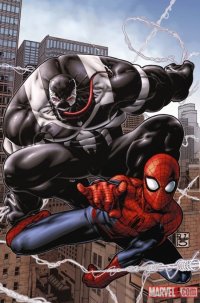 AMAZING SPIDER-MAN #654.1 (Marvel Comics, $2.99)
AMAZING SPIDER-MAN #654.1 (Marvel Comics, $2.99)
By Devon Sanders
Can I just say I’ve always been a huge Flash Thompson fan? Not for the reasons you may think. I was never a bully, although I do wish the word “pantywaist” would re-enter the greater slander/contempt lexicon. I like him because deep down inside, he is basically a good guy who, in his own weird way, always tries to do what he thinks is best. From always standing up for his favorite hero, Spider-Man to volunteering to fight in Viet Nam and willingly going into Iraq, Flash has always been simply the perfect “lug.” With Amazing Spider-Man #654.1, the qualities that make Flash the man he is, could very well prove to be his undoing.
Despite the loss of his legs, Flash is, once again, ready to serve his country in any way he can. The U.S. government needs a new soldier, one able and willing to go where his brothers and sisters simply can’t. To keep them and the world out of harm’s way, Flash volunteers once again. He will attempt to tame and redeem what many men before could not. Flash Thompson has become America’s newest weapon, it’s newest super-soldier. Flash Thompson is Venom. May he be left with a soul for God to save.
Writer Dan Slott crafts a seamless set-up and primer for Marvel’s soon-to-debut Venom series. Slott’s scripting is full of understanding of exactly what it takes to make someone like Flash tick, portraying Flash as the ultimate fixer. Flash is, as ever, loyal to those who shows an interest and as eager to please as ever. Slott has Thompson stretch himself waaay too thin and the final six pages will crush the heart of anyone who’s come to care about this character over his nearly 50 years of existence. Very good work, Dan Slott.
Artist Humberto Ramos is at his artistic best in this issue. While he still maintains the somewhat cartoony elements that brought him to the dance, what you readily see is a greater command of pertinent artistic detail, anatomy and page layout. Ramos has become a deft hand at drawing just what a scene needs. From Flash being tender with his girlfriend Betty Brant to going full-on Venom against those who’d do harm, Ramos shows why nearly twenty years into the business, he’s regarded as one of the best.
Amazing Spider-Man #654.1displays exactly why Spider-Man is and always will be one of my favorite comics. The character of Spider-Man appears on nary a page, instead allowing Peter Parker’s supporting cast shows its depth. With Flash taking up the mission to become a new Venom, we’re witnesses at ground zero of one of comics’ most clever reinventions. Sadly, this will be the ultimate Flash Thompson story.
Rating: 




Out of a Possible 5 Stars
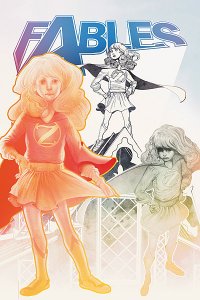 Fables #102 (Vertigo, $2.99)
Fables #102 (Vertigo, $2.99)
by Graig Kent
It’s been a few years since I last picked up an issue of Fables, having left the book feeling content with the series by the conclusion of the war with the Adversary. My wife remains an avid reader and fan of the book so the title has still been readily available to me, and I have flippe through the occasional issue but, aside from a guest art fill-in from Mike Allred, nothing has truly lured me back. Until now.
The latest story arc of Fables is “Super Team”, and I believe it’s clearly designed to hook comic readers like me, superhero fans who either abandoned or have been resistant to checking out the title. Or perhaps that’s just my ego, and it’s really all about writer Bill Willingham having more-fun-than-usual on the title, adding some silliness amidst the looming darkness.
For the uninitiated/unfamiliar, Fables is about fairy tale characters that exist in the “real world” but segregating themselves into their own community, generally hidden from the world. That they have odd appearances, special abilities or both is natural given their various origins in children’s literature, so thrusting them into spandex is not unexpected, but rather poses the question “what took them so long?”
Then again, Fables treads heavily in fantasy fare, not superhero, so the worry is that forcing this concept into the mix is an ill-fit. This first (of five) parts doesn’t necessarily dismiss that worry, as it’s Pinocchio playing the meta-commentator, rolling around in a Professor X/The Chief style wheelchair, expositing the true purpose behind the masks and capes with a semi-wink towards the reader. Willingham works it into the story-at-large he’s obviously been building, as the Fables are being pressured and threatened by the fear-fed, nefarious and powerful Mister Dark and are left with no other choice to fight back, and Pinocchio explains how the costumes will feed into confidence and fight fear. It’s thin, but at the same time, it is indeed fun, for me at least.
Artists Mark Buckingham and Steve Leialoha equally seem to be having fun, adding in some Jack Kirby influences here and there, in use of shadows, angles, and I believe I even spied some Kirby Dots. Their work is richly detailed and deceptively effortless. Having been the art team for the bulk of the series, Buckingham and Leialoha deliver the characters all with a sense of familiarity, understanding how they move, how their faces contort, every nuance, like actors well settled into their roles. As a result there’s a warmth, a lived in feel to the book that is rather inviting.
For a lost reader returning, I found the story and set-up easy to follow. A brand-new reader may not feel as comfortable, but I think there’s more than enough here to lend a sense of excitement and anticipation for the coming battle between a Fables super-team and Mister Dark.
Rating: 




Out of a Possible 5 Stars
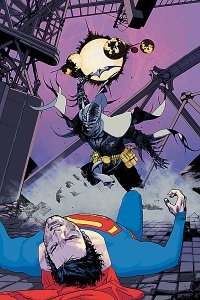 Superman/Batman #81 (DC Comics, $2.99)
Superman/Batman #81 (DC Comics, $2.99)
by Graig Kent
Somewhere along the way the Superman/Batman title has transitioned from a DC Universe centerpiece into an anthology series of asides, with a variety of creators coming on board telling quasi-in-continuity stories pertaining to the joint exploits of certain Misters Kent and Wayne. I think the title is better suited to this set-up anyway, as the exploits of the two premiere players in comics shouldn’t really feel like a regular thing, even if it is. Having a rotating group of creators come in makes each story stand apart from the others, while also giving it a sense of “special”, just as previous anthologies like Legends of the Dark Knight and Superman Confidential did. Of course, one can never anticipate the quality from story-to-story, so being a regular reader an anthology title can feel like a crapshoot for some, but for others it can be liberating by picking up only stories by creators of interest, treating it like a series of mini-series rather than an ongoing.
I’m of the latter mind, having last picked up the book for Paul Levitz’s “Worship” last year, and now jumping aboard for Sixth Gun creator Cullen Bunn’s first foray into the DC Universe. With “Sorcerer Kings” Bunn shows both his knowledge and interest in the DCU, and also a keen desire to play with it.
The opening pages find members of the Shadowpact encountering a battle between a mysterious armored figure and a horde of demonic-looking creatures. When the dust settles the Shadowpact are left confused and with the armored warrior laying dead at their feet. As they investigate the situation further, the Phantom Stranger brings Superman into the mix, and they encounter an unfamiliar magic-wielding Batman. The Shadowpact quickly realizes they are way out of their league, and have, naturally, only one person to turn to.
Bunn’s story is quite out there, in a good way, using familiar characters in unconventional ways without sacrificing their established personalities. I appreciate the use of the c-list DCU characters, and how naturally Bunn uses them as a starting point to a Superman/Batman adventure. In Bunn’s dialogue, as well, he has a great feel for each character’s voice, a particular exchange between two detectives is the highlight of the book.
Bunn is joined by the art team of Chriscross and Marc Deering, who handle the proceedings with much energy (oh man, the speed lines). I used to be a really big fan of Chriscross, but have lost track of him in recent years, to the point where his art is a little unfamiliar to me. I last recall his work being on the level of a Kevin Maguire, very clean, attractive, with natural sensibilities and a flair for facial expressions, but here his figures and backgrounds seems less patient, less calculated. Perhaps as a result of inker Deering’s influence or perhaps just an evolution of how he draws? That said it serves the story more than well enough , but I guess it’s just not pretty as I was expecting.
This is a damn enjoyable start to what should be a creatively wild story, with plenty of mystery to be still to be worked out.
Rating: 




Out of a Possible 5 Stars
 SILVER SURFER #1 OF 5 (Marvel, $2.99)
SILVER SURFER #1 OF 5 (Marvel, $2.99)
By Jeb D.
While I’m pleased with the high level of quality that Marvel’s been able to maintain with its various “cosmic” series in recent years, I’ve always preferred Norrin Radd as the homeless wanderer, trapped and remorseful on Earth, to seeing him cruise the universe. My favorite Silver Surfer stories are those that contrast his immense power with the frailty of the humans who never fail to win his sympathy, even as they disappoint him; that are rooted in the gulf between the possibilities inherent in the Power Cosmic and the guilt resultant from its use. Greg Pak’s excellent work on the underappreciated Warlock miniseries a few years back feels now like a dry run for his take on the Kirby-Lee-Buscema vintage Surfer.
The book opens with Norrin taking a bit of a break while Galactus sleeps off the effects of gorging himself on the energy of a star; resulting, so we are told, in that star’s race being extinguished in four billion years instead of what would otherwise have been five—nice balance there: the Surfer’s actions will cause untold misery in a time unimaginably distant, so it doesn’t seem a big deal to the reader, but he still gets to feel guilty about it!
Naturally, brooding on Earth being a specialty (there’s a nice bit where he ruefully notes that he can’t even get dirty, because dirt won’t stick to his skin), our hero just happens to be in the right place to watch the human condition debase itself yet again, as a young couple find themselves victim to the brutality of government-sponsored soldiers on a drug raid. Naturally, savage humans with guns bring out the worst (best?) in the Surfer, and he intervenes in several pages of glorious mayhem, with result both expected and unexpected. I won’t spoil more of the particulars of the plot, save to admire the way that Pak manages to synch his story up with both Chaos War and the current X-Men continuity, and to thank him for bringing Force Works’ Cybermancer back into the picture. He’s also got a crackerjack cliffhanger at the end of the issue; and one that, while perfectly logical, I’m not sure I’ve seen used in a Surfer comic before.
Artist Stephen Segovia leans toward the narrow-waisted Buscema version of the character, though he seems to take a few more liberties with facial expression than might be thought appropriate. He certainly knows how to bring the ‘splode, and Pak gives his script the right balance, so that Segovia’s art maintains an effective pace between action and rumination.
Marvel is probably wise to assume that the reading audience prefers their secondary characters in bite-size miniseries, rather than doomed-to-fail ongoings. If this mini continues as strongly as it begins, though, you’d be forgiven for wishing (hoping?) that Pak and Segovia might be on the character for a long run.
Rating: 




Out of a Possible 5 Stars
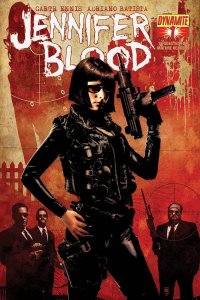 JENNIFER BLOOD #1 (Dynamite, $3.99)
JENNIFER BLOOD #1 (Dynamite, $3.99)By Jeb D.
The idea of a woman who’s a suburban housewife and mom by day, trained killer by night, is a fairly easy high-concept pitch. You can imagine it being gripping or dumb, over-the-top unbelievable or drab, funny or sad. All depends who’s writing it. What you might not have expected, with Garth Ennis writing, would be for it to be relatively restrained.
Even if you’re fond of Ennis’ more grotesque work, you have to give him credit for taking the time to do more than give a female character the same blithe violent confidence as someone like, say, Billy Butcher, and call it a day: Jennifer Blood is intelligent without the “cute” arrogance of the usual comic-book badass, she’s tough without having to compensate for a lack of testosterone, one reason she’s good at what she does is that she engages in old-fashioned reading and research. Jennifer tells her story mostly in the form of journal entries, providing not only a kind of dry detachment from the horror of a life spent dealing death, but a nicely practical perspective on the details of just how one hides such lethality from the other members of a typically nuclear family (her methods are both efficient and sometimes quietly horrifying, but always make perfect sense). Most of this first issue deals with such stage-setting details, while dropping a few hints as to the purpose and target of her lethal activities, and worrying about the effect all this could have on her husband and kids. It’s a little predictable, but only because Ennis grounds her double life in as much logic and practicality as such a fanciful story will permit: this issue is obviously just a curtain-raiser, but Jennifer Blood herself is company worth keeping as the story unfolds in future issues.
I don’t want to slight artist Adriano Batista (or inker Romulo Fajardo, Jr) here: for those accustomed to the buckets o’ blood that artists like Jacen Burrows deal up on Ennis favorites like Crossed, the big action setpiece toward the end of the book may feel a little on the dry side; he more than makes up for that with a sanguinary little side trip that Jennifer takes on her way back home. His domestic scenes are a bit stiff and bland, but of course that contrast between the rigidity of suburbia and the fluidity of nocturnal vigilantism is very much to the point.
Don’t get the wrong impression here: Jennifer Blood is a Garth Ennis book with all that implies in terms of bitter observations of the beastliness of humanity, and a willingness to decorate the page with severed limbs. But where he can sometimes be fairly accused in reveling in that sort of thing, in Jennifer Blood he seems to be subsuming those impulses in favor of clear, direct storytelling. Looking forward to learning more next issue.
Rating: 




Out of a Possible 5 Stars